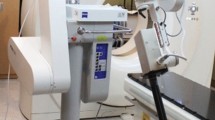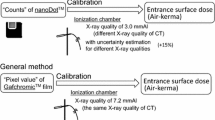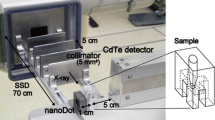Abstract
For X-ray diagnosis, the proper management of the entrance skin dose (ESD) is important. Recently, a small-type optically stimulated luminescence dosimeter (nanoDot OSL dosimeter) was made commercially available by Landauer, and it is hoped that it will be used for ESD measurements in clinical settings. Our objectives in the present study were to propose a method for calibrating the ESD measured with the nanoDot OSL dosimeter and to evaluate its accuracy. The reference ESD is assumed to be based on an air kerma with consideration of a well-known back scatter factor. We examined the characteristics of the nanoDot OSL dosimeter using two experimental conditions: a free air irradiation to derive the air kerma, and a phantom experiment to determine the ESD. For evaluation of the ability to measure the ESD, a calibration curve for the nanoDot OSL dosimeter was determined in which the air kerma and/or the ESD measured with an ionization chamber were used as references. As a result, we found that the calibration curve for the air kerma was determined with an accuracy of 5 %. Furthermore, the calibration curve was applied to the ESD estimation. The accuracy of the ESD obtained was estimated to be 15 %. The origin of these uncertainties was examined based on published papers and Monte-Carlo simulation. Most of the uncertainties were caused by the systematic uncertainty of the reading system and the differences in efficiency corresponding to different X-ray energies.





Similar content being viewed by others
References
Amy Berrington de Gonzalez, Sarah Darby. Risk of cancer from diagnostic X-ray: estimates for the UK and 14 other countries. Lancet. 2004;363:345–51.
Uffmann M, Prokop CS. Digital radiography: the balance between image quality and required radiation dose. Eur J Radiol. 2009;72:202–8.
Komiya I, Shirasaka T, Umezu Y, Tachibana M, Izumi T. Patient dose measurement with fluorescent glass dosimeter: characteristics evaluation and patient skin dose measurement in abdominal interventional radiology. Jpn J Radiol Technol. 2003;60(2):270–7 (In Japanese).
Hatori N, Habu T, Sakaino K, Matsumoto M, Niibe H, Katoh M. Practical use and characteristics of thermoluminescence dosimeters as a personal monitor. Jpn J Radiol. 1977;37(7):691–702 (In Japanese).
Matsunaga Y, Kawaguchi A, Kobayashi K, Asada Y, Takikawa Y, Yamada M, Suzuki S. Dose estimation for exposure conditions of diagnostic radiology acquired by a 2011 questionnaire in a phantom study. Jpn J Radiol Technol. 2013;69(12):1372–8 (In Japanese).
Grosswendt B. Backscatter factors for x-rays generated at voltages between 10 and 100 keV. Phys Med Biol. 1954;29(5):579–91.
Klevenhagen SC. Experimentally determined backscatter factors for x-rays generated at voltages between 16 and 140 kV. Phys Med Biol. 1989;34(12):1871–82.
Grosswendt B. Dependences of the photon backscatter factor for water on source-to-phantom distance and irradiation field size. Phys Med Biol. 1990;35(9):1233–45.
Kato H. Method of calculating the backscatter factor for diagnostic X-rays using the differential backscatter factor. Jpn J Radiol Technol. 2001;57(12):1503–10 (In Japanese).
Jursinic PA. Characterization of optically stimulated luminescent dosimeters, OSLDs, for clinical dosimetric measurements. Med Phys. 2007;34(12):4594–604.
Reft CS. The energy dependence and dose response of a commercial optically stimulated luminescent detector for kilovoltage photon, megavoltage photon, and electron, proton, and carbon beams. Med Phys. 2009;36(5):1690–9.
Lehmann J, Dunn L, Lye JE, Kenny JW, Alves ADC, Cole A, Asena A, Kron T, Williams IM. Angular dependence of the response of the nanoDot OSLD system for measurements at depth in clinical megavoltage beams. Med Phys. 2014;41(6):061712-1-9.
Kerns JR, Kry SF, Sahoo N, Followill DS, Ibbott GS. Angular dependence of the nanoDot OSL dosimeter. Med Phys. 2011;38(7):3955–62.
Al-Senan RM, Hatab MR. Characteristics of an OSLD in the diagnostic energy range. Med Phys. 2011;38(7):4396–405.
Hayashi H, Nakagawa K, Okino H, Takegami K, Okazaki T, Kobayashi I. High accuracy measurements by consecutive readings of OSL dosimeter. Med Imaging Inf Sci. 2014;31(2):28–34 (In Japanese).
Tappouni R, Mathers B. Scan quality and entrance skin dose in thoracic CT—a comparison between bismuth breast shield and posteriorly centered partial CT scans. ISRN Radiol. 2013; article ID 457396.
Kobayashi I, Suzuki A, Sekiguchi H, Morishima H. Discussion on light annealing method of OSL dosimeter. Jpn J Radiat Saf Manag. 2002;1(2):84–8 (In Japanese).
Nakagawa K, Hayashi H, Okino H, Takegami K, Okazaki T, Kobayashi I. Fabrication of annealing equipment for optically stimulated luminescence (OSL) dosimeter. Jpn J Radiol Technol. 2014;70(10):1135–42 (In Japanese).
Takegami K, Hayashi H, Konishi Y, Fukuda I. Development of multistage collimator for narrow beam production using filter guides of diagnostic X-ray equipment and improvement of apparatuses for practical training. Med Imaging Inf Sci. 2013;30(4):101–7 (In Japanese).
Hubbell JH. Photon mass attenuation and energy-absorption coefficients from 1 keV to 20 MeV. Int J Appl Radiat Isot. 1982;33:1269–90.
Hirayama H, Yoshihito N, Bielajew AF, Wilderman SJ, Nelson WR. The EGS5 Code System. SLAC Report number: SLAC-R-730. KEK Report number: 2005-8. 2013.
Birch R, Marshall M. Computation of bremsstrahlung X-ray spectra and comparison with spectra measured with a Ge(Li) detector. Phys Med Biol. 1979;24(3):505–17.
Tucker DM, Barnes GT, Chakraborty DP. Semiempirical model for generating tungsten target x-ray spectra. Med Phys. 1991;18(2):211–8.
Hayashi H, Fukumoto A, Hanamitsu H, Nishihara S, Kamiya N. Practical calculation method of diagnostic X-ray spectrum using EGS5 code. Med Imaging Inf Sci. 2012;29(3):62–7 (In Japanese).
Hayashi H, Takegami K, Okino H, Nakagawa K, Okazaki T, Kobayashi I. Procedure to measure angular dependences of personal dosimeters by means of diagnostic X-ray equipment. Med Imaging Inf Sci. 2015;32(1):8–14.
Okazaki T, Hayashi H, Takegami K, Okino H, Nakagawa K. Evaluation of angular dependence of nanoDot OSL dosimeters toward direct measurement of entrance skin dose. Eur Congr Radiol (EPOS#3009). 2015;. doi:10.1594/ecr2015/C-0721.
Conflict of interest
T. Okazaki and I. Kobayashi are employees of Nagase Landauer, Ltd. and collaborating researchers.
Author information
Authors and Affiliations
Corresponding author
About this article
Cite this article
Takegami, K., Hayashi, H., Okino, H. et al. Practical calibration curve of small-type optically stimulated luminescence (OSL) dosimeter for evaluation of entrance skin dose in the diagnostic X-ray region. Radiol Phys Technol 8, 286–294 (2015). https://doi.org/10.1007/s12194-015-0318-1
Received:
Revised:
Accepted:
Published:
Issue Date:
DOI: https://doi.org/10.1007/s12194-015-0318-1




